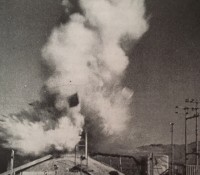BORAX, SPERT Tests; INL at 70!
Idaho National Laboratory is celebrating 70 years of operation in the mission of advancing knowledge in the field of nuclear technology. Materials, methods - even basic questions about feasibility of certain concepts - have been tested and proven at this historic, and quite large remote facility in the Idaho desert over all these years. A number of notable firsts have occurred there, including the first operation of a nuclear plant designed for shipboard use (STR, later S1W) as well as tests for the (abortive) nuclear bomber program. Thousands of valuable test hours were racked up by samples in the legendary Materials Test Reactor and its neighbor the Engineering Test Reactor - both now gone, their former sites mostly now a parking lot.
One of the concepts tested for theoretical feasibility at the site - originally, the National Reactor Testing Station - was that of the boiling water reactor. While it seemed fairly obvious and probably workable to have the coolant and moderator boil in the reactor core itself, there were many questions about stability and about transient behavior of the core of such a design. The NRTS was just the place needed to perform the experiments required to prove out the ideas being developed (mostly at Argonne National Laboratory.)
To that end, the Boiling Reactor Experiments (BORAX) were begun in 1953 at NRTS with the construction of a 1.2 MWt experimental reactor contained in a mound not far from the site of the historic Experimental Breeder Reactor 1. The arrangement of the BORAX-I reactor is shown below.
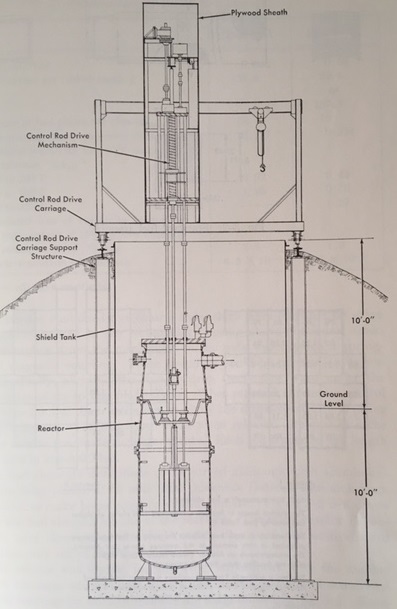
BORAX-1 was operated in a wide range of transient tests, in order to determine how the development of steam voids inside the core during critical operation affected the reactor's ability to turn power or damp transients. It was found that the reactor was quite stable under most operative schemes, and importantly the reactor proved that with refinement the boiling water concept would be quite workable for power reactors. With all practical testing concluded, an impractical but nevertheless experimentally important test was decided upon; the reactor would be subjected to an extremely rapid step insertion of positive reactivity through the ejection of a control rod. This test would prove whether or not the steam void effect would halt the nuclear reaction at an early stage of the violent disassembly of the core - a test considered necessary if the absolute safety of boiling water reactors was to be assured.
Much of the testing, up to and including the final destructive test, was captured in a remarkable film, featured here.
The importance of the final test as a closed cover on the experience of the BORAX-I tests is captured in "Boiling Water Reactors" (Kramer, US AEC 1958) on page 79:
"Satisfied that the boiling water concept was feasible, after the destruction of this first reactor in the summer of 1954, Walter H. Zinn* and his associates at Argonne made plans to construct a new reactor, one capable of operating at higher pressures and also with a much larger core than that of BORAX-I. In the meantime, however, it was also decided to build a more practical plant for the actual generation of power. This, eventually, became EBWR, or Experimental Boiling Water Reactor, built at the Lemont site of the Argonne National Laboratory near Chicago."
Regardless of the successes of the BORAX series of reactors I through IV (started up through 1957) there were still some questions about safety, themselves brought about after observation of the BORAX reactors themselves. While the EBWR and related plants would research the steady power operation aspect of boiling water reactors (with economic power generation in view) another series of tests at NRTS was initiated, this time to the East off Fillmore Blvd. to further explore safety aspects during severe transients. This series of tests, known as SPERT ("Special Power Excursion Reactor Tests") was run by Phillips Petroleum Company, site operator of NRTS for the AEC.
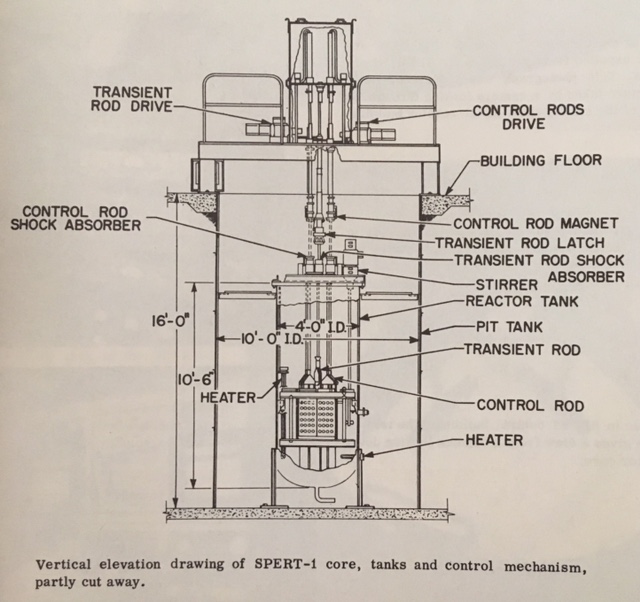
SPERT-I arrangement. Note that no coolant system, or power production system is involved in this extremely simple but rugged test design.
SPERT-I was constructed very simply, rather like BORAX-I. This test reactor would be subjected to similar but more violent transients which, ultimately, would result in the destruction of the reactor as at the end of the BORAX-I tests.
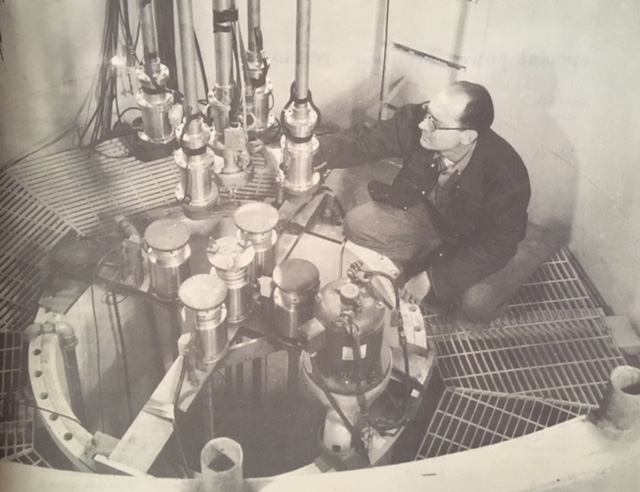
View of the top of the SPERT-I reactor showing control rod drives, and instruments.
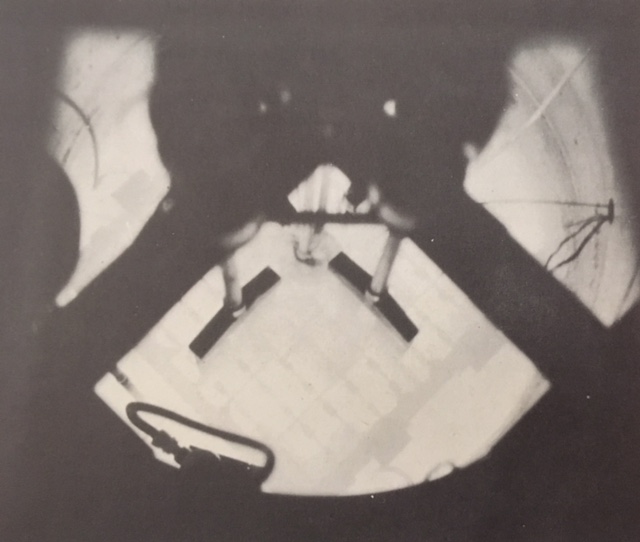
This pulse test of the SPERT-I reactor was photographed entirely by the light of the Cherenkov glow in the core.
As mentioned, the severity of transient testing with the SPERT-I reactor increased until, eventually, a complete destructive test was performed. This was also captured on film and is presented below.
These violent transient tests, culminating in destruction only for the BORAX-I and SPERT-I reactors, were considered absolutely necessary to be able to describe the behavior of boiling water reactors under all possible and even remotely possible conditions. The US Atomic Energy Commission had purchased NRTS, now INL, for just such purposes - the testing of advanced nuclear concepts did at that time come with some risk, and believe it or not, boiling water reactors were considered an advanced technology in the mid-late 1950's. These final tests (for each above named reactor) proved conclusively that even with such a rapid insertion of reactivity as to not be normally credible, boiling water reactors would not explode with any nuclear yield. A steam explosion would take place, but the violent formation of the steam would halt the nuclear reaction through removal of the moderating quality of liquid water in the core. In fact, in the final destructive BORAX-I test the Cherenkov glow of the power transient only lasted some 0.003 seconds, and the power transient was halted before any water actually began to be ejected from the core itself. To quote The Atomic Energy Deskbook on this test, "..the experiment dramatically confirmed the self-quenching characteristic of steam void formation which had been observed in the earlier less violent power excursions."
Of course, these highly dramatic tests are just one aspect of the operation of some 52 different reactors at INL over the past 70 years. Being destructive tests, they're the most dramatic - and they couldn't happen the same way today. However, INL continues to lead in the development of safe nuclear technology in a much different way as it prepares to host the world's first multi-module Small Modular Reactor nuclear plant in the coming decade - a decade that will move INL's positive impact on nuclear technology well into the 21st Century and, hopefully, beyond.
Sources:
The Atomic Energy Deskbook, John Hogerton; Reinhold Publishing Corporation, New York, 1963.
Boiling Water Reactors, Andrew Kramer; US Atomic Energy Commission, 1958.
Experimental Power and Test Reactors, TID-4562; US Atomic Energy Commission, 1956.
Please feel free to leave a constructive comment for the author below!
 Will Davis is a member of the Board of Directors for the N/S Savannah Association, Inc. He has been a contributing author for Fuel Cycle Week, and he used to write his own popular blog Atomic Power Review. Davis is also a consultant and writer for the American Nuclear Society, and serves on the ANS Communications Committee and the Book Publishing Committee. He is a former U.S. Navy reactor operator and served on SSBN-641, USS Simon Bolivar. His popular Twitter account, @atomicnews is mostly devoted to nuclear energy. He has an Instagram at @williamdavis5500, but that's mostly dog photos.
Will Davis is a member of the Board of Directors for the N/S Savannah Association, Inc. He has been a contributing author for Fuel Cycle Week, and he used to write his own popular blog Atomic Power Review. Davis is also a consultant and writer for the American Nuclear Society, and serves on the ANS Communications Committee and the Book Publishing Committee. He is a former U.S. Navy reactor operator and served on SSBN-641, USS Simon Bolivar. His popular Twitter account, @atomicnews is mostly devoted to nuclear energy. He has an Instagram at @williamdavis5500, but that's mostly dog photos.


